Butterflies are the most fascinating creatures in the world, and they are known for their shape, color, and size. You may have seen many butterflies in your backyard or during field trips.
These butterflies not only amazed us with their beautiful color but also had some spiritual meanings.
How will you identify a species of butterfly? Probably because of their unique colors and patterns. In this post, you will learn about different types of yellow and black butterflies. Let’s start this beautiful journey.
What is the spiritual meaning of a yellow and black butterfly?
The colors yellow and black have great value in spirituality. Yellow color is associated with warmness, excitement and happiness whereas black color is associated with power, sophistication , elegance and emptiness.
As in these butterflies both the yellow and black color are present and are known for their striking combination which symbolize power, sophistication and positive energy and the emptiness of black color is fill by warmness of yellow color.
24 Yellow and Black Butterflies
1. Eastern tiger swallowtail butterfly
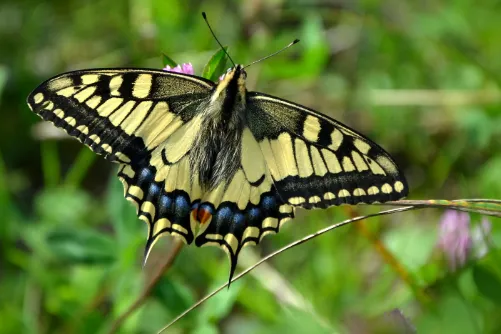
| Scientific name | Papilio glaucus |
| Size | 5.5 cm |
| Geographical location | Eastern united states, Ontario, Canada |
| Identification | Have yellow with four black tiger strips on forewings |
This group of butterflies is very common in the eastern United States and Ontario, Canada.
They are quite large, with a wingspan of 8 to 14 cm.
They are vibrant yellow in color with four black stripes, which are known as tiger stripes, on their forewings, as they resemble the tiger.
Females of this species are dimorphic. These largest butterflies are diurnal and inhabit woodlands and gardens.
2. Androgeus Swallowtail

| Scientific name | Papilio androgeus |
| Size | 134-140 mm |
| Geographical location | Mexico, Argentina |
| Identification | have yellow wings with black markings |
They are known as Queen Swallowtails because of their largest size and striking appearance; this name is given to this butterfly in honor of Queen Elizabeth.
Both sexes are easily distinguishable from each other, as females are larger than males and have totally different appearances.
Female wings are turquoise in color with blue-green markings, whereas male wings are yellow with black markings.
They have an average wingspan of 134–140 mm.
The caterpillars of these butterflies are green with black markings and can be seen on the leaves of citrus trees.
3. Yellow Glassy Tiger
| Scientific name | Parantica aspasia |
| Size | 60-75 mm |
| Geographical location | Indian subcontinent |
| Identification | have tiger-like appearance |
This Asian native butterfly belongs to the group of brush-footed butterflies.
These butterflies have brownish wings with bright yellow and black markings.
They are known as “yellow glassy tigers” due to their resemblance to tigers in appearance, which represent strength and power.
According to recent data, they are extinct in Singapore. This butterfly demonstrates both Batesian and Mullerian mimicry. They fly slowly and can be frequently seen in forested areas.
4. Giant Swallowtail
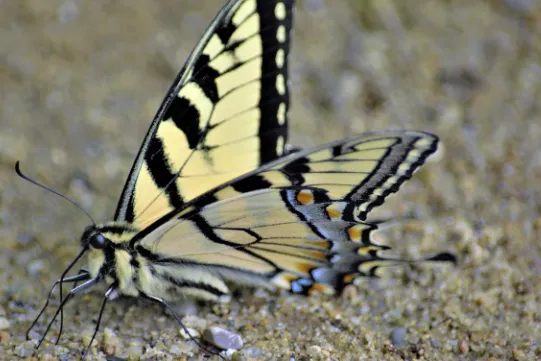
| Scientific name | Papilio cresphontes |
| Size | 5.5-7.4 cm |
| Geographical location | North America |
| Identification | have black wings with yellow lines |
Swallowtail butterflies show distinctive characters and have a prominent appearance.
It is the largest butterfly species found in North America.
They are known for their size; females have an average wingspan of 5.5 to 6.9 inches, and males have wingspans up to 5.8 to 7.4 inches.
They have black wings with horizontal and diagonal yellow lines across the hindwings.
Their caterpillars are known as “orange puppies,” as they cause serious harm to the citrus trees.
In their pupa stage, they are more prone to parasitic attacks.
5. Southern Festoon
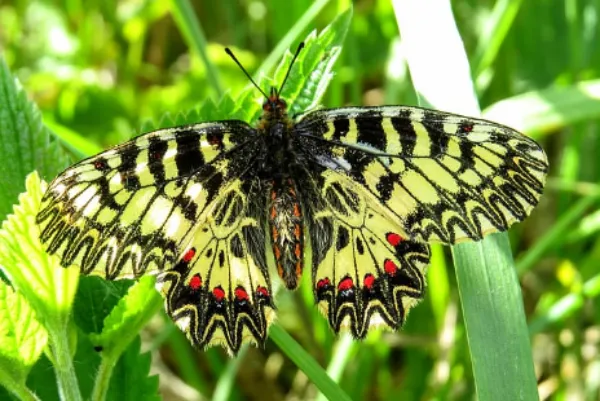
| Scientific name | Zerynthia polyxena |
| Size | 46-52 mm |
| Geographical location | Europe , kazakhstan |
| Identification | have black markings on wings |
We are back with another swallowtail butterfly, i.e., the southern festoon. It has a wingspan of 46–52 mm.
They have yellow wings with intricate patterns and black markings.
They are widely distributed in middle and southern Europe, coming from Kazakhstan.
Females have larger and lighter-colored wings than males. They have aposematic coloration to warn the predators that they are not going to be a tasty meal!
6. Northern Chequered Skipper

| Scientific name | Carterocephalus silvicola |
| Size | 13 mm |
| Geographical location | Europe, Western Scotland |
| Identification | have disc-shaped black spots |
This fast-flying butterfly is endemic to the damp, grassy habitat of western Scotland.
Recently, they were introduced in some parts of Ireland and Europe as a part of long-term conservation plans.
As compared to the above butterflies, they are smaller in size and have a wingspan of 13 mm.
Their wings are yellow with brown-black disc-shaped spots. Females of this species are less frequently visible than males.
7. Spanish Festoon
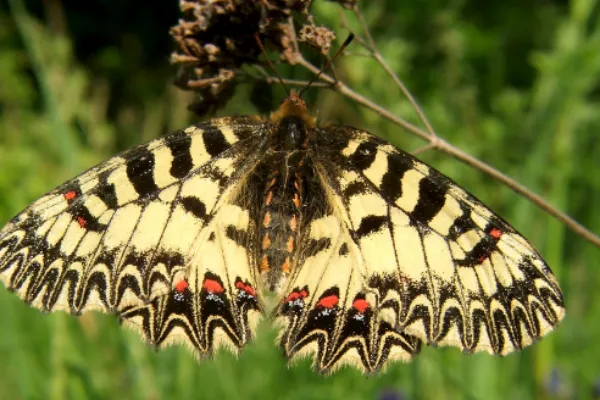
| Scientific name | Zerynthia rumina |
| Size | No information |
| Geographical location | Southern France |
| Identification | have red spots on their wings |
The Spanish festoon is a magnificent butterfly that can be seen in southern France.
People often confuse it with the southern festoon. but they have remarkable differences in their wings.
Their wings have red spots on them, which are absent in the southern festoon.
Their wings have ornate patterns of yellow, black, and brown. It’s dazzle coloration often confuses the predators about where to attack.
If you really want to see this butterfly, then April and May will be better times to watch.
8. Yellow Pansy
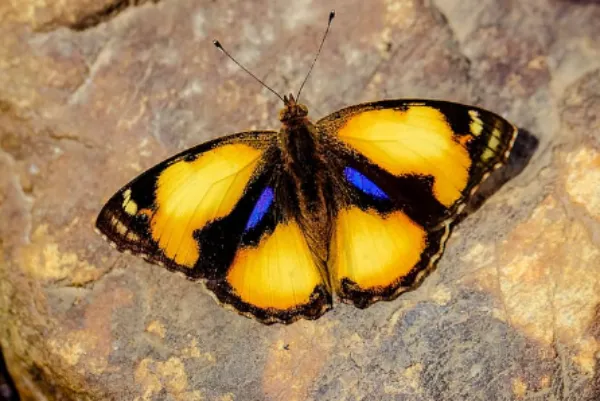
| Scientific name | Junonia hierta |
| Size | 2-2.5 inches |
| Geographical location | Africa, Southeast Asia |
| Identification | have black edges on yellow wings |
This butterfly belongs to the Nymphalidae family. This scrub- and grassland-inhabited species can be found in Africa and Southeast Asia. Polymorphism can be seen in this butterfly.
Females can be easily distinguished from males by their wing patterns.
They have yellow wings with black edges and white spots.
You can find these beautiful creatures in arid regions like grasslands, semi-deserts, etc. This paleotropical butterfly is considered migratory.
9. Cairns Birdwing
| Scientific name | Ornithoptera euphorion |
| Size | 12.5-15 cm |
| Geographical location | Australia |
| Identification | have yellow and green flashes on their wings |
The Cairns birdwing, the northern birdwing, and the Cooktown birdwing are the common names of Ornithoptera euphorian, the endemic species of Australia.
Their wingspan can reach up to 15 cm in females and 12.5 cm in males.
It is the largest butterfly species found in Australia. Males have black wings with yellow and green flashes, whereas females have black wings with white patches, and females are comparatively larger than males.
They are known for their rare genetic mutations.
10. Chocolate Albatross
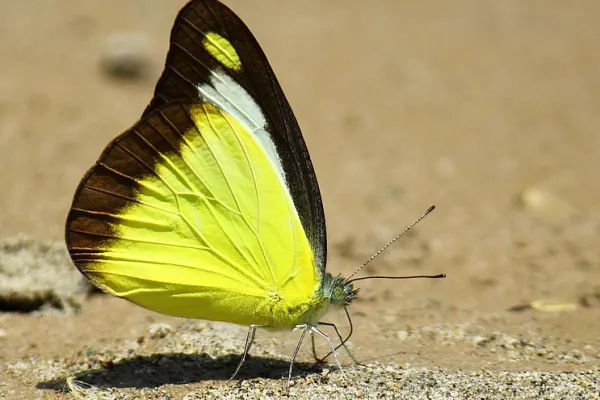
| Scientific name | Alppias lyncida |
| Size | 55-70 mm |
| Geographical location | Asia |
| Identification | have chocolate brown margins |
The chocolate albatross is native to the Indian subcontinent. It is a tropical species of the Pieridae family, commonly found in Asia.
Males have yellow wings with chocolate brown and black margins, whereas females have whitish wings with chocolate brown markings.
It is found in forests and along stream banks, and it has an average wingspan of 55 to 70 mm.
They exhibit seasonal dimorphism and variability in dry-season and wet-season forms.
11. Mourning Cloak
https://in.pinterest.com/pin/809873945503579267/
| Scientific name | Nymphalis antiopa |
| Size | 4 inches |
| Geographical location | North America, Britain |
| Identification | have yellow margins with blue spots |
The Mourning Cloak in North America and the Camberwell Beauty in Britain are the common names of Nymphalis antiopa.
It is a large butterfly with unique markings and an average wingspan of 4 inches.
The upper side of the wings is dark maroon in color with yellow edges, and there is a black demarcation line between yellow and brown, whereas the lower side has grey striations.
Sexual dimorphism is absent in this butterfly. This butterfly displays polygynous mating behavior. They have the longest lifespan among butterflies (11–12 months).
12. Yellow Coster Butterfly

| Scientific name | Acraea issoria |
| Size | No information |
| Geographical location | Western Himalayas |
| Identification | Have coaster-like black markings |
The yellow coaster butterfly is the smallest butterfly in the Nymphalidae family.
They are known for their small size and leathery wings. Their hard endoskeleton protects them from predators.
It is commonly found in the western Himalayas. They have an average wingspan of 5–6 cm.
The upper side of their wings is yellow with black markings, which have a coaster-like appearance.
That’s why they are named yellow coster butterflies, whereas the lower side is orange with black markings.
They secrete harmful secretions from their leg glands.
13. Western Tiger Swallowtail
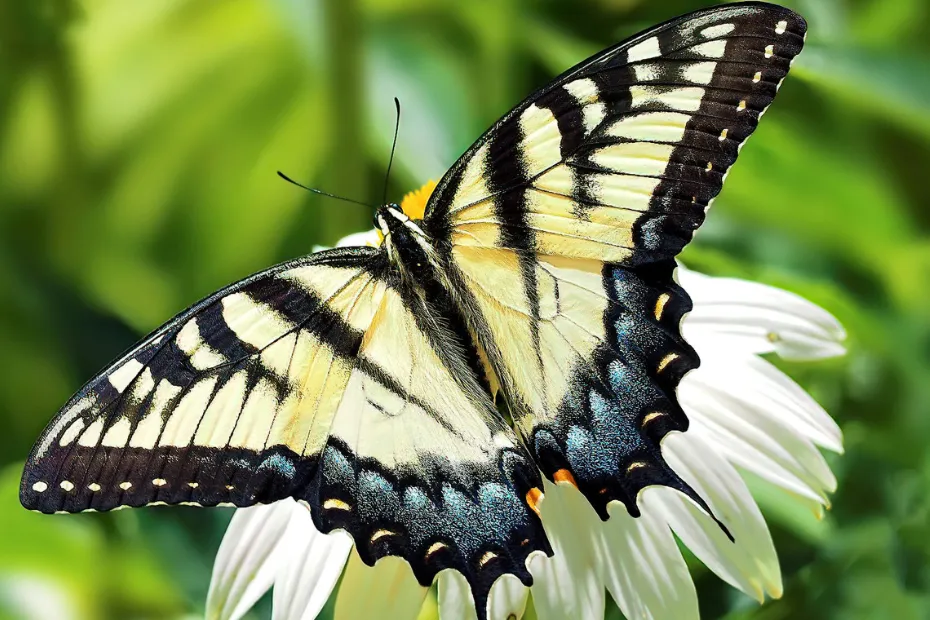
| Scientific name | Papilio rutulus |
| Size | 7-10 cm |
| Geographical location | Western North America |
| Identification | have blue-white spots on tail |
Let’s talk about another swallowtail butterfly, i.e., the western tiger swallowtail.
This rural, woodland-inhabited species is commonly found in western North America.
These large butterflies have an average wingspan of 7–10 cm.
Their wings are yellow with black markings, and they have blue and white spots on their tails.
Butterfly enthusiasts can see this butterfly in February and March.
It’s quite difficult to take pictures of these butterflies, as they hardly take rest.
Their caterpillars are green and have yellow eyes with blue pupils.
14. Yellow Jezebel
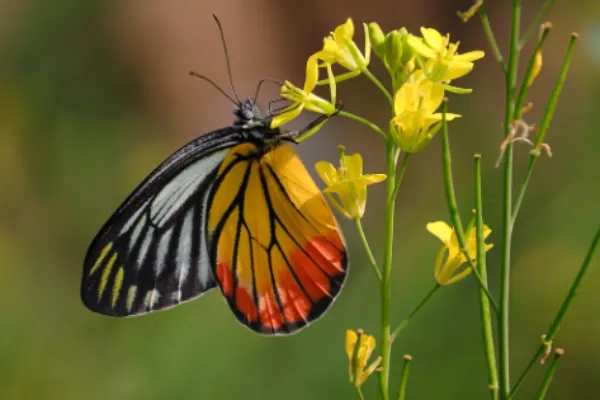
| Scientific name | Delias agostina |
| Size | 2.5-3 inches |
| Geographical location | India, Southeast Asia, and Australia |
| Identification | have black and yellow bands on underside of their wings |
If you are an entomologist, then you must have seen this butterfly in your lab.
It is commonly found in India, Southeast Asia, and Australia and has an average wingspan of 2.5–3 inches.
They are Mullerian mimics, and they often mimic crow butterflies to stay away from predators.
This flying butterfly is a long-distance migrant and can migrate up to 1000 miles.
The upper side of their wings is white with black markings, whereas the lower side is yellow with black bands.
15. African Caper
| Scientific name | Belenois creona |
| Size | 40-45 mm |
| Geographical location | Afrotropical realm |
| Identification | their underwings are yellow in color |
African common white, or African caper, belongs to the family Pieridae, i.e., the yellows and whites.
The upper sides of their wings are white with black veins, whereas the undersides are yellow with black markings.
It exhibits both Mullerian and Batesian mimicry.
They are found in a variety of habitats, including savannas, forests, and grasslands.
They are well known during the summer and autumn, when large numbers migrate towards Southeast Asia.
16. Yucca Giant Skipper
| Scientific name | Megathymus yuccae |
| Size | 50-75 mm |
| Geographical location | United states, Mexico |
| Identification | are brownish black with yellow margins |
As the name indicates, the Yucca giant skipper is a large and robust-bodied butterfly.
Adults have a wingspan of 50–75 mm. Females are larger than males and have more rounded forewings.
The wings are brownish black with a yellow outer band, which varies in both sexes.
This species is univoltine and produces generation from February to May.
Females commonly lay eggs on the leaves of Adam’s needle.
They are quite uncommon and found in the United States and northern and southern Mexico.
17. Painted Lady
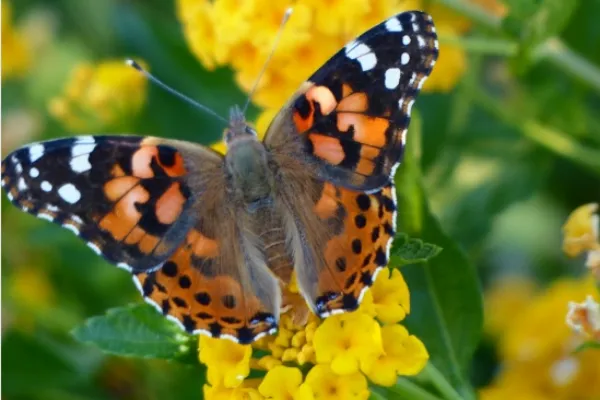
| Scientific name | Vanessa cardui |
| Size | No information |
| Geographical location | In all continents expect Antarctica and South America |
| Identification | have yellow orangish wings with irregular black bands and white spots. |
The painted lady is the most common butterfly found all across the world, on all continents except Antarctica and South America. They stay only in warmer areas and migrate to Britain and Europe in May and June.
Their migration pattern commonly follows a north-west heading. They are known for continuous mating throughout all seasons, including winters.
Their visual system resembles that of a honey bee. Let’s talk about appearances.
Their forewings are yellow orangish in color with irregular black patterns, whereas their hind wings have black spots from the costal vein to the end of the tail.
18. Yellow-orange tip
| Scientific name | Ixias pyrene |
| Size | 50-55 mm |
| Geographical location | Sri Lanka, India and Southeast Asia |
| Identification | sulphur yellow wings with orange and black tip |
Another member of the family Pieridae, the yellow-orange tip is commonly found in India, Sri Lanka, and southeast Asia.
Their larvae commonly feed on capparis. Their appearance is quite distinctive.
As the name indicates, males have yellow wings with an orange and black tip, whereas females have white wings with an orange tip. If you want to see this butterfly, then morning time is best for it.
19. Golden Birdwing
| Scientific name | Troides aeacus |
| Size | 150-170 mm |
| Geographical location | Indian subcontinent |
| Identification | hindwings have black and yellow patterns |
Being a member of the swallowtail family, this large butterfly is found only in tropical climates.
They have an average wingspan of 150–170 mm and are found in countries of the Indian subcontinent.
Their appearance is quite magnificent. The forewings are black with white bands, while the hindwings have remarkable black and yellow patterns. They appear to be all black while flying.
20. Hydaspes eighty-eight
| Scientific name | Callicore hydaspes |
| Size | 35-35 mm |
| Geographical location | Brazil, Peru, and Argentina |
| Identification | Their hindwings have distinct black and yellow patterns. |
When you see this butterfly from above, it will not appear as a black and yellow butterfly.
Their forewings have incredible black, blue, and red patterns. whereas their hind wings have remarkable black and yellow patterns.
This forest-inhabiting butterfly belongs to the Nymphalidae family and is commonly found in Brazil, Peru, and some parts of Argentina.
21. Orange Sulphur
| Scientific name | Colias eurytheme |
| Size | 5 cm |
| Geographical location | North America |
| Identification | Have red bordered spots on their wings |
Orange sulphur is characterized by bright yellow or orange wings with black dots and margins.
They can be easily identified by the red border spots on their wings.
They are found all throughout North America, from Mexico to southern Canada.
Also called alfalfa butterflies because their primary food source is alfalfa plants.
Males can be easily distinguished from females by their appearance.
They use the reflective pattern of their hindwings to attract the females.
22. Pale-banded Crescent
| Scientific name | Anthanassa tulcis |
| Size | 3.2–3.5 cm |
| Geographical location | North America |
| Identification | Have black wings with yellow spots and bands |
Tulcis crescent or pale-banded crescent are some of the common names of Anthanassa tulcis.
One can find them in North America, from Argentina north through Central America and Mexico to South Texas, and sometimes they stray to west Texas and southern Arizona.
They have black wings with yellow spots on the margins and a yellow band, which makes them distinctive.
23. Mexican Dartwhite
| Scientific name | Catasticta nimbice |
| Size | 45–57 mm |
| Geographical location | Costa Rica and Mexico |
| Identification | Have yellow wings with black veins and thick margins |
Catasticta nimbice is called Pine White or Mexican Dart White because of its distinct pine tree habitat and geographic location.
They are found from Costa Rica to Mexico. These butterflies have a pale yellow tint with distinctive black veins and broad borders, as this image makes evident.
Primarily, they feed on parasitic mistletoes and nectar from various flowers.
24. Soldier pansy
| Scientific name | Junonia terea |
| Size | 50 to 60 mm |
| Geographical location | Sub-Saharan Africa, the southern Arabian Peninsula, the island of Madagascar, and the islands of the western Indian Ocean |
| Identification | Blackish-brown top side with white spots on their wings |
Known as soldier pansy or soldier commodore, most likely because of their distinctive wings’ brown, black, or yellow coloring that mimics certain military garb.
The afro tropical region, which includes Madagascar, the southern Arabian Peninsula, Sub-Saharan Africa, and the islands of the western Indian Ocean, is home to them.
They can attain a size of 50 to 60 mm. Just look at them from above; they exhibit beautiful patterns of black, brown and yellow on the wings.
Conclusion
Now we come to the end of this article. You must have gained some knowledge about many yellow and black butterflies and their characteristic behaviors.
They have a unique appearance and have kept on fascinating us for centuries. We will talk about another group of animals in the next article; until then, enjoy the butterfly varieties.
Also Read:

Being a zoology student I’m always been fascinated toward animals especially insects. I love to do research and learn about different animals. As a writer I want to share my thoughts about nature through my articles. Apart from this you can find me exploring the new places and voice notes.

